
ISSN: 2321 9653; IC Value: 45.98; SJ Impact Factor: 7.538

Volume 10 Issue XI Nov 2022 Available at www.ijraset.com


ISSN: 2321 9653; IC Value: 45.98; SJ Impact Factor: 7.538

Volume 10 Issue XI Nov 2022 Available at www.ijraset.com
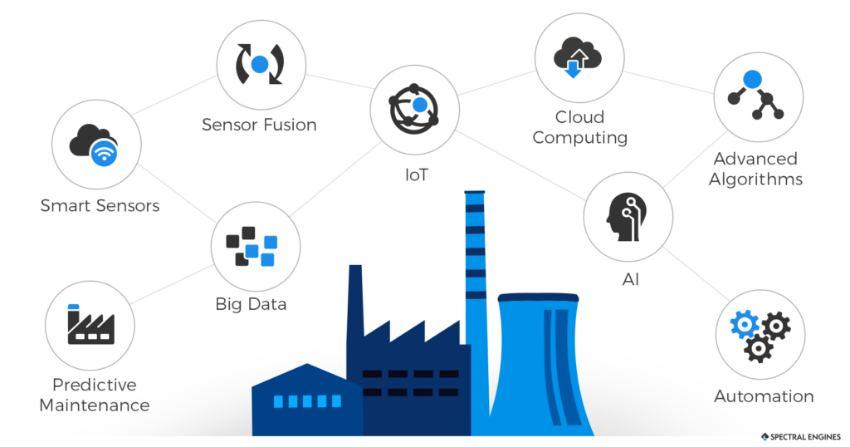 K Yaswanth Raj1 , P A Harsha Vardhini2 1, 2Department of ECE, Vignan Institute of Technology and Science Deshmukhi, Telangana, India
K Yaswanth Raj1 , P A Harsha Vardhini2 1, 2Department of ECE, Vignan Institute of Technology and Science Deshmukhi, Telangana, India
Abstract: Industrial automation has historically been finished with wired structures. Wireless versions swiftly rising in commercial communique because of the extended ease of setting up with wireless structures. In addition to the capacity wired structures are bulky. Industrial automation structures are used for circumstance monitoring, control programs, and the mobile workforce. Common to all commercial automation programs are the necessities for international availability of components, coexistence among wired and wireless technologies, lifetime, security, and interoperability. The wireless generation is hastily rising to fulfill those needs. Industry 4.0 is revolutionizing the manner organizations manufacture, enhance and distribute their products. Manufacturers are integrating new technologies, together with the Internet of Things (IoT), cloud computing and analytics, and AI and machine learning into their manufacturing centres and in the course of their operations. This digital technology results in improved automation, predictive maintenance, self-optimization of techniques enhancements and, above all, a brand new degree of efficiencies and responsiveness to clients now no longer formerly possible. Using high tech IoT devices in smart factories ends in better productiveness and progressed best. Replacing manual inspection enterprise models with AI powered visible insights reduces production mistakes and saves cash and time. With minimum investment, quality control personnel can set up a smart phone linked to the cloud to monitor production processes from simply anywhere. By making use of machine learning algorithms and equipping themselves with the right tools now, such as rugged IT equipment, enterprise resource planning and manufacturing execution systems, manufacturers can create an IT infrastructure that allows them to capitalize on these exciting new technologies at the earliest opportunity.
Keywords: Cloud, Arduino, Sensors, IoT, Industry.
In traditional industries, machinery used for production still uses the old fashion of control. For example, if a switch needs to turn on and off 50 machines at a time, then it comes with a challenge like heavy wiring and wiring supported infrastructure. Even with that support, it needs a robust wire and switch. Shorting between any 2 wires can do a lot of damage that can cost a hefty amount or even a person's life. To eliminate these problems, Industry 4.0 came up with the integration of IoT and Cloud and many more. Doing so will help position them at the forefront of the sector and future proof their investment for many years to come, manufacturers can hit upon mistakes immediately, instead of at later tiers while restoring work is extra expensive. In this work, the use of IoT and the cloud to make an effective machinery control system is illustrated. The total working procedure is addressed into 3 sections for a single control operation, such as turning ON and OFF.section1 consists of the cloud and its integration with IoT and the working procedure. IoT, Cloud Computing & MQTT protocol are presented in Section 2. Section 3 consists of Input device construction, working and its integration with the cloud. Output device construction, working and its integration with the cloud and Section 4 concludes the work
ISSN: 2321 9653; IC Value: 45.98; SJ Impact Factor: 7.538

Volume 10 Issue XI Nov 2022 Available at www.ijraset.com
Cloud computing permits users to carry out computing obligations through the usage of services provided over the Internet. The use of the Internet of Things alongside cloud technology has turned out to be a type of catalyst: the Internet of Things and cloud computing at the moment are associated with every different. These are real technology of destiny to be able to convey many benefits. Due to the speedy boom of technology, the trouble of storing, processing, and gaining access to massive quantities of data has arisen. Great innovation pertains to the mutual use of the Internet of Things and cloud technology. In combination, it'll be viable to apply effective processing of sensory data streams and new monitoring services. As an example, sensor data may be uploaded and stored in the usage of cloud computing for later use as smart tracking and activation of the usage of different gadgets. It is vital to observe that cloud architecture have to be well designed on account that reliability, security, economy, and overall performance optimization rely upon it. Using well designed CI/CD pipelines, structured services, and sandboxed environments outcomes in stable surroundings and agile development. Cloud is a centralized system supporting to switch and supply of data and documents to data centres over the Internet. A form of data and applications are smooth to get entry to from a centralized cloud machine. The Internet of Things refers to devices related to the Internet. In the IoT, data is saved in real time, in addition to historic data. The IoT can examine and train devices to make powerful decisions, in addition to tuning how sure actions function. For communication between the device and cloud, MQTT protocol is used, since it requires a minimal amount of code and consumes very less power, thus energy efficient and easy to deploy for millions of devices. It ensures guaranteed delivery of messages to receivers, even when connections between devices are unreliable and speedy communication between cloud servers and IoT devices in remote areas. It uses the last will feature to broadcast a relevant message to other IoT devices in the network and has extensive support in programming languages such as Python, making it very easy for developers to use it.
In a nutshell, MQTT makes use of your current Internet domestic network to send messages to your IoT devices and reply to those messages. MQTT (Message Queuing Telemetry Transport) is a publish/subscribe messaging protocol that works on top of the TCP/IP protocol. Suitable for connecting devices with a small code footprint, MQTT is a great desire for wi fi networks that revel in various levels of latency because of occasional bandwidth constraints or unreliable connections. MQTT makes it easy to transmit extraordinarily lightweight messaging between the server and the client. It makes use of Internet Protocol (IP) as its direction to send messages. Generally, the MQTT gateway may be described as a middleman among any internet of things platform and sensors. It works by getting information from those sensors or smart devices and translating it into MQTT. It then transmits that information to both the internet of things platform and the MQTT broker.
1) Broker: The broker is the server that distributes the records to the interested clients linked to the server.
2) Client: The device that connects to the broker to send or obtain data.
3) Topic: The name that the message is about. Clients publish, subscribe, or do both to a topic.
4) Publish: Clients that send data to the broker to distribute to interested clients primarily based totally on the topic name.
5) Subscribe: Clients inform the broker which topic(s) they’re interested in. When a client subscribes to a topic, any message published to the broker is sent to the subscribers of that topic. Clients also can unsubscribe to prevent receiving messages from the broker about that topic. MQTT is a publish/subscribe messaging protocol. Clients will connect to the network, which can subscribe to or publish a topic. When a client publishes a topic, the data is sent to the broker, which then is distributed to all the clients that are subscribed to that topic.9 Topics are arranged in a directory like structure. A topic might be “Livingroom”, or “Livingroom/Light” if you have multiple clients within that parent topic. The subscriber client will listen for incoming messages from the subscribed topic and react to what was published on that topic, such as “on” or “off”. Clients can subscribe to one topic and publish to another as well. If the client subscribes to “Livingroom/Light”, it might also want to publish to another topic like “Livingroom/Light/State” so that other clients can monitor the state of that light.
Here the Adafruit IO cloud server is used to connect an MQTT client to Adafruit IO:
a) Host: io.adafruit.com
b) Port: 1883 or 8883 (for SSL encrypted connection)
c) Username: your Adafruit account username (see the accounts.adafruit.com page here to find yours)
d) Password: your Adafruit IO key (click the AIO Key button on a dashboard to find the key)
ISSN: 2321 9653; IC Value: 45.98; SJ Impact Factor: 7.538 Volume 10 Issue XI Nov 2022 Available at www.ijraset.com

Adafruit IO's MQTT API exposes feed data using special topics. You can publish a new value for a feed to its topic, or you can subscribe to a feed's topic to be notified when the feed has a new value. Any one of the following topic forms is valid for a feed: (username)/feeds/(feed name or key) (username)/f/(feed name or key)
Rate Limit: Adafruit IO's MQTT server imposes a rate limit to save you an immoderate load at the service. If a user performs too many publish actions in a quick period, then a number of the publish requests is probably rejected. The modern rate limit is at maximum 1 request consistent with a second (or 60 requests within 60 seconds).
Data Format: The simplest way to send values to an IO Feed topic is to just send the value. For example, a temperature sensor is going to produce numeric values like 22.587.you can send using a numeric data type or a string data type. That means either 22.587 or "22.587" will be accepted and stored as a numeric value.
Data with Location: To tag your data with a location value, you'll either need to wrap it in a JSON object first or send it to the special /CSV formatted MQTT topic. JSON objects must include a "value" key, and may include "lat", "lon", and "ele" keys. The proper format for location tagged JSON data is:
{
"value": 22.587, "lat": 38.1123, "lon": 91.2325, "ele": 112 }
Adafruit Dashboards permit us to visualize data and manage Adafruit IO related tasks from any present day web browser. Widgets including charts, sliders, and buttons are to be had that will help us quickly get our IoT task up and running without the need for any custom code. The web dashboard interface as in fig.2 consists of each device's control switches, each switch in the dashboard can control each output device
Each switch acts as a publisher which sends the data in bits format like “1” and “0”. The associated subscriber to that topic takes the data and acts upon it with the help of the output device. In this way, created a scope where many subscribers can subscribe to the data from Topic which is published by a single Publisher without any hassle and errors. The below Flowchart shows the working flow of Adafruit IO cloud MQTT along with the Input and Output device.


The below Fig. 3 a shows the working flow of Adafruit IO cloud MQTT along with the Input and Output device. Component arrangement , which can give multi input ways to control the output device. Fig.3. Design Implementation
ISSN: 2321 9653; IC Value: 45.98; SJ Impact Factor: 7.538 Volume 10 Issue XI Nov 2022 Available at www.ijraset.com

The input device acts as a data sender i.e., Publisher which publishes data to a topic which can be subscribed by a subscriber. Components required are Arduino NodeMCU, a Gesture sensor, a sound sensor, and connecting wires. Each component has its respective duty of instruction data for a sound sensor take a single input that is Sound above threshold level gives data that data can be toggled between the Boolean values like True and False and Gesture sensor has 4 respective inputs those are directional gestures like UP, DOWN, LEFT, RIGHT. on registering its respective direction input it toggles between the value of True and False, Here True and False act as ON and OFF i.e., the value of “1” and “0”. Here sound sensor acts as a safety assuring device the sound received from the surroundings above the threshold value can turn OFF all the Machines Subscribed to its Topic and thus Gesture sensor can control individual Subscribers. Arduino Node MCU is a microcontroller where it is programmed to instruct working procedures and receive data from the respective Sensors, along this it can also publish the sensor input instruction data to a Topic of the Adafruit IO cloud server The following circuit diagram in Fig. 4a shows the arrangement of the components, which can give multi input ways to control the output device. (a) (b) (c)
Fig. 4 (a) Arrangement of Components, (b) Arduino NodeMCU, (c) Guesture Sensor

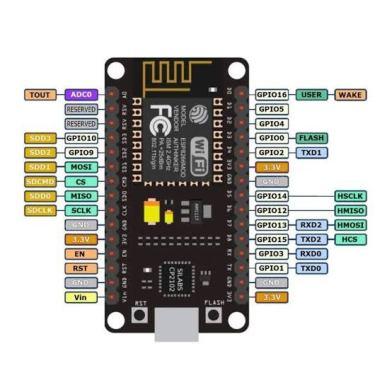
Node MCU as in fig. 4b consists of ESP8266 12E Wi Fi Module. It is the strongest tool to interface the Wi Fi networking. Node MCU is a kind of device which aims to work with an objective of the Internet of Things. This chip can be programmed easily with Arduino IDE or LUA language. A Wireless Fidelity link can be established with ease. It joins the highlights of the Wi Fi access point and station along with the microcontroller. The data will be uploaded by establishing a link with the server. Because of this advantage, it becomes the potential tool which establishes the connection with Wi Fi and creates a direct way to develop IoT based projects. The power supply for the board is provided in different ways. Supply of 3.3V is given to the module. It can also be powered with the development kit with the help of an off board regulator. It can manage the power supply to the module around 6 to 12V.Here, the point is to be noted that if the device is operating at the power of 3.3V then the regulator is not used for supplying the power. Since it does not provide 3.3V to the device.
The APDS9960 is used in many places. As shown in Fig.4c, it is used for gesture detection, ambient and RGB light sensing, proximity sensing etc. It can be used to give the RGB ratings of the light because many times need a particular RGB rated light, so that can be manipulated accordingly. It is used in many phones to disable the screen while someone is dialling the phone and keeping it on the ear. The sensor uses an I2C communication protocol so that makes it super easy to use with microcontrollers. It operates on a voltage range of 2.4V 3.6V (Typically 3.3V) and consumes a really small current of 0.2mA so it is a power efficient sensor. The sensor gives the RGB values directly so you don’t need to do any calculations to fetch them.
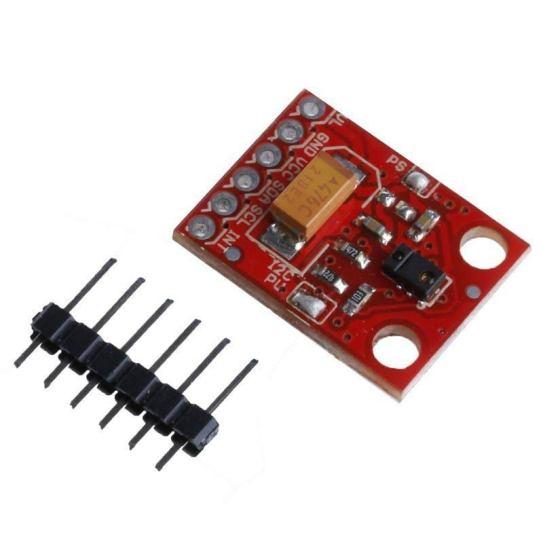
As in Fig. 5a, the sound detection sensor module for Arduino detects whether the sound has exceeded a threshold value. Sound is detected via microphone and fed into an LM393 op amp. The sound level set point is adjusted via an onboard potentiometer. When the sound level exceeds the set point, an LED on the module is illuminated and the output is sent low.
Operating voltage 3.3V 5V
Outputs digital switching output (high and low levels 0 and 1)
Operating current (Vcc=5V): 4 8mA
Microphone sensitivity (1Khz): 52 48dB
Microphone Impedance: 2.2KΩ
Microphone Frequency: 16 20Khz
Microphone S/N ratio: 54dB
Signal output indication
Single channel signal output
Outputs low level and the signal light when there is sound
ISSN: 2321 9653; IC Value: 45.98; SJ Impact Factor: 7.538

Volume 10 Issue XI Nov 2022 Available at www.ijraset.com
Fig. 5 (a) Sound Sensor (b) Arrangement of Components Arduino NodeMCU, (c) Relay
The Output device acts as a Data receiver and respective action performer i.e., the subscriber subscribes to Topics which are published by a publisher. Components required are Arduino NodeMCU,2 channel Relay module and connecting wires. Here Relay module acts as a switch and is connected to the respective device, which needs to be controlled. The relay module is controlled using an Arduino Node MCU microcontroller. On the output side the Arduino Node MCU receives the data from the cloud server i.e., it subscribes from the respective Topic which is published by the publisher and respective ON and OFF actions are performed with the help of the Relay module. Each Relay can be connected to one appliance, with the help of the cloud and IoT we can control the output of each appliance from anywhere in the world. Here the Arduino does not communicate directly with the input device, the cloud acts as a mediator between the input device and the output device. If multiple appliances need to perform the same action of single input instruction, then they can just to their respective Topic of the Publisher and there is no limit, this procedure is completely wireless and the control instruction data can be given from anywhere in the world and appliance can be controlled from anywhere which gives the high priority to control from anywhere. The following circuit diagram as in Fig. 5b shows the arrangement of the components of the output device which are connected to the appliances.
As in fig. 5c, 2 Channel 5V Relay Module is a relay interface board, it can be controlled directly by a wide range of microcontrollers such as Arduino, AVR, PIC, ARM and so on. It uses a low level triggered control signal (3.3 5VDC) to control the relay. Triggering the relay operates the normally open or normally closed contacts.
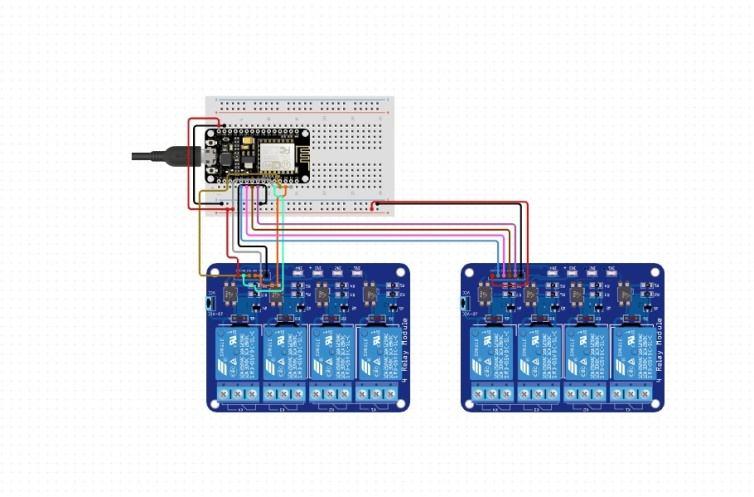
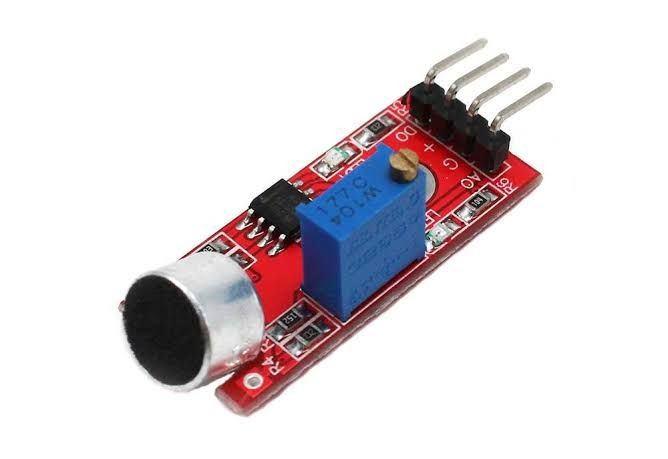
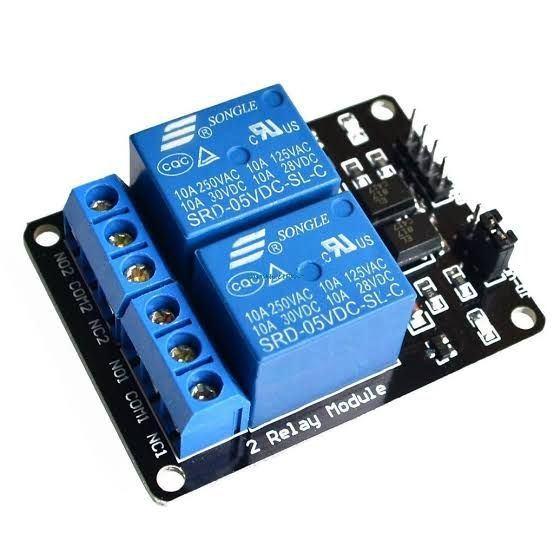
ISSN: 2321 9653; IC Value: 45.98; SJ Impact Factor: 7.538 Volume 10 Issue XI Nov 2022 Available at www.ijraset.com


It is frequently used in an automatic control circuit. To put it simply, it is an automatic switch to control a high current circuit with a low current signal.5V relay signal input voltage range, 0 5V. VCC power to the system. JD VCC relay in the power supply. JD VCC and VCC can be shorted. This kind of combinational usage of different technologies together can bring a big picture of easy doing of difficult things, quality control, precise manufacturing, cost reduction, safety assurance of workers and machines, global access to control factories, production value increment and can solve innovative challenges. The implementation of the design with the above mentioned procedure is illustrated in Fig. 6 (a) (b) (c) (d) Fig. 6 (a) Top View (b) Side View (c) Top View (d) side view

By making use of machine learning algorithms and equipping with the right tools such as rugged IT equipment, enterprise resource planning and manufacturing execution systems, manufacturers can create an IT infrastructure that allows them to capitalize on these exciting new technologies at the earliest opportunity. Doing so will help position them at the forefront of the sector and future proof their investment for many years to come, manufacturers can hit upon mistakes immediately, instead of at later tiers while restoring work is extra expensive. Since cloud servers are used to control, increased the scope of advancement, by proper usage of server API (Application programming interface), Fog and Edge Computing services are added for a more robust Manufacturing process. If a switch needs to turn on/off 50 machines at a time, then it comes with a challenge like heavy wiring and wiring supported infrastructure. Even with that support, it needs a robust wire and high durability switch. In a normal fashion for such control, either connecting devices in series or parallel connection is used. But in series connection, if any one machine gets off due to some circumstances, then other machines in the series connections get off, hence the parallel connection is the best method. But connecting each device parallell to switch is not ideal procedure and Shorting between any 2 wires can do a lot of damage that can cost a hefty amount or even a person's life. This limitation is addressed successfully with Industry 4.0 with the integration of IoT and Cloud and many more
[1] Vanga, M.S.R., Vijayaraj, J., Kolluru, P., Latchoumi, T.P. (2022). Semantics Driven Safety Measures in Distributed Big Data Systems on IoT. In: Gandhi, T.K., Konar, D., Sen, B., Sharma, K. (eds) Advanced Computational Paradigms and Hybrid Intelligent Computing . Advances in Intelligent Systems and Computing, vol 1373. Springer, Singapore. https://doi.org/10.1007/978 981 16 4369 9_26.

ISSN: 2321 9653; IC Value: 45.98; SJ Impact Factor: 7.538 Volume 10 Issue XI Nov 2022 Available at www.ijraset.com
[2] J. Kuppala, K. K. Srinivas, P. Anudeep, R. S. Kumar and P. A. H. Vardhini, "Benefits of Artificial Intelligence in the Legal System and Law Enforcement," 2022 International Mobile and Embedded Technology Conference (MECON), 2022, pp. 221 225, doi: 10.1109/MECON53876.2022.9752352.
[3] Vardhini, P. H., Ravinder, M., Reddy, P. S., & Supraja, M. (2019). IoT based wireless data printing using raspberry pi. Journal of Advanced Research in Dynamical and Control Systems, 11(4), 2141 2145.
[4] L Jayakumar, R Jothi Chitra, J Sivasankari, S Vidhya, Laura Alimzhanova, Gulnur Kazbekova, Bakhytzhan Kulambayev, Alma Kostangeldinova, S Devi, Dawit Mamiru Teressa, “QoS Analysis for Cloud Based IoT Data Using Multicriteria Based Optimization Approach”, Computational Intelligence & Neuroscience, Volume 2022, Article ID 7255913. https://doi.org/10.1155/2022/7255913
[5] P. A. Harsha Vardhini and G. Janardhana Raju, "Design of Internet of Things Based Smart and Efficient Water Distribution System for Urban and Agriculture Areas", Journal of Computational and Theoretical Nanoscience, vol. 17, no. 9 10, pp. 4688 4691(4), September/October 2020.
[6] N. Karennagari, K. Yashwanth Reddy, V. K. Gurrala, K. Srinivas, A. Peddi and Y. Padma Sai., "Infection Segmentation of Leaves Using Deep Learning techniques to enhance crop productivity in smart agriculture," 2021 6th International Conference on Signal Processing, Computing and Control (ISPCC), 2021, pp. 368 372, doi: 10.1109/ISPCC53510.2021.9609379.
[7] Mishra P, Jimmy L, Ogunmola GA, Phu TV, Jayanthiladevi A, Latchoumi T (2020) Hydroponics cultivation using real time iot measurement system. Journal of physics: conference series. IOP Publishing, p 012040. https://doi.org/10.1088/1742 6596/1712/1/012040
[8] Vardhini, P. H., Koteswaramma, N., & Babu, K. M. C. (2019). IoT based raspberry pi crop vandalism prevention system. International Journal of Innovative Technology and Exploring Engineering, 9(1), 3188 3192.
[9] B. V. Kumar, K. K. Srinivas, P. Anudeep, N. S. Yadav, G. V. Kumar and P. A. Harsha Vardhini, "Artificial Intelligence Based Algorithms for Driver Distraction Detection: A Review," 2021 6th International Conference on Signal Processing, Computing and Control (ISPCC), 2021, pp. 383 386, doi: 10.1109/ISPCC53510.2021.9609349.
[10] K. K. Srinivas, A. Peddi, B. G. S. Srinivas, P. A. H. Vardhini, H. L. P. Prasad and S. K. Choudhary, "Artificial Intelligence Techniques for Chatbot Applications," 2022 International Mobile and Embedded Technology Conference (MECON), 2022, pp. 292 296, doi: 10.1109/MECON53876.2022.9751887.
[11] K. M. Chandra Babu and P. A. Harsha Vardhini, "Brain Computer Interface based Arduino Home Automation System for Physically Challenged," 2020 3rd International Conference on Intelligent Sustainable Systems (ICISS), 2020, pp. 125 130, doi: 10.1109/ICISS49785.2020.9315999.
[12] Latchoumi, T. P., Loganathan, J., & Ezhilarasi, T. P. (2017). Detecting Generic Objects by using an adaptation of Spatial features. Journal of Advanced Research in Dynamical and Control Systems, 9, 45 53.
[13] K. K. Srinivas, A. Peddi, S. K. Ramakuri, P. A. H. Vardhini, P. S. Avinash and R. Sirimalla, "Artificial Intelligence Driven Techniques to Advanced Signals and Communication Systems," 2022 International Mobile and Embedded Technology Conference (MECON), 2022, pp. 307 310, doi: 10.1109/MECON53876.2022.9752011.
[14] J. Loganathan, Logitha and A. Veronica, "Distributed resource management scheme using enhanced artificial bee colony in P2P," 2015 2nd International Conference on Electronics and Communication Systems (ICECS), 2015, pp. 1035 1039, doi: 10.1109/ECS.2015.7124737.
[15] Vardhini, PA Harsha, et al. "Power optimized Arduino baggage tracking system with finger print authentication." Journal of Applied Science and Computations J ASC 6.4 (2019): 3655 3660.
[16] D. Kothandaraman, N. Praveena, K. Varadarajkumar, B. Madhav Rao, Dharmesh Dhabliya, Shivaprasad Satla, Worku Abera, "Intelligent Forecasting of Air Quality and Pollution Prediction Using Machine Learning", Adsorption Science & Technology, vol. 2022, Article ID 5086622, 15 pages, 2022. https://doi.org/10.1155/2022/5086622
[17] Vardhini, P. H., & Hanku, V. Energy Efficient Implementation of IoT based Home Irrigation System Using Raspberry Pi. In 1st International Conference on Advanced Technologies in Engineering Management & Sciences (pp. 218 223).
[18] R. S. Krishna, K. K. Srinivas, P. Anudeep and P. A. H. Vardhini, "Ear Based Biometric System Using Artificial Intelligence," 2021 6th International Conference on Signal Processing, Computing and Control (ISPCC), 2021, pp. 377 382, doi: 10.1109/ISPCC53510.2021.9609409.
[19] K. M. C. Babu and P. A. Harsha Vardhini, "Design and Development of Cost Effective Arduino based Object Sorting System," 2020 International Conference on Smart Electronics and Communication (ICOSEC), 2020, pp. 913 918, doi: 10.1109/ICOSEC49089.2020.9215269.
[20] Kandala Kalyana Srinivas et.al., “ Machine Learning Techniques To Predict, Forecast And Diagnosis Of Covid 19”, International Research Journal of Modernization in Engineering Technology and Science, Volume. 4, Issue. 6, June 2022.
[21] N. Saude and P. A. H. Vardhini, "IoT based Smart Baby Cradle System using Raspberry Pi B+," 2020 International Conference on Smart Innovations in Design, Environment, Management, Planning and Computing (ICSIDEMPC), 2020, pp. 273 278, doi: 10.1109/ICSIDEMPC49020.2020.9299602.
[22] N. Ananthula and P. A. H. Vardhini, "Design and Implementation of Internet of Things based Spybot," 2021 IEEE International Conference on Intelligent Systems, Smart and Green Technologies (ICISSGT), 2021, pp. 63 67, doi: 10.1109/ICISSGT52025.2021.00024.
[23] N. Ananthula, T. Rajeshwari, B. Mounika, P. A. Harsha Vardhini and B. Kalyani, "Arduino based Rescue device with GPS Alert for Women Safety Application," 2022 International Mobile and Embedded Technology Conference (MECON), 2022, pp. 343 347, doi: 10.1109/MECON53876.2022.9751817.
[24] K. Srinivas, Cluster based dense using hybrid genetic and grasshopper optimization algorithm in WSN. J. Netw. Commun. Syst. 4(3) (2021).
[25] P. Sandeep, J. V. Rao, P. A. H. Vardhini, Y. Shanmukha Lakshmi Sai, A. Raju Sagar and P. Phaneendhar, "Arduino based Economical Floor Cleaning Robot," 2022 International Mobile and Embedded Technology Conference (MECON), 2022, pp. 263 267, doi: 10.1109/MECON53876.2022.9752317.
[26] Iyappan, P.; Loganathan, J.; Kumar Verma, M.; Dumka, A.; Singh, R.; Gehlot, A.; Vaseem Akram, S.; Kaur, S.; Joshi, K. A generic and smart automation system for home using internet of things. Bull. Electr. Eng. Inform. 2022, 11, 2727 2736.
[27] Babu, K. M. C., Vardhini, P. H., & Koteswaramma, N. (2019). Design and Implementation of Arduino based Riders Safe Guard 2.0. International Journal of Innovative Technology and Exploring Engineering (IJITEE), 9(1), 3078 3083.
[28] K.Srinivas,"Prediction of E Learning Efficiency by Deep Learning in EKhool Online Portal Networks",Multimedia Research, vol. 3, no. 4, October 2020.
